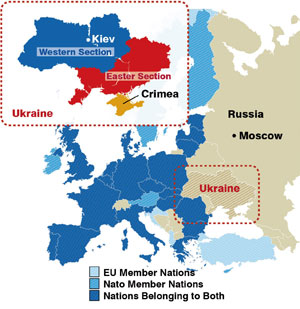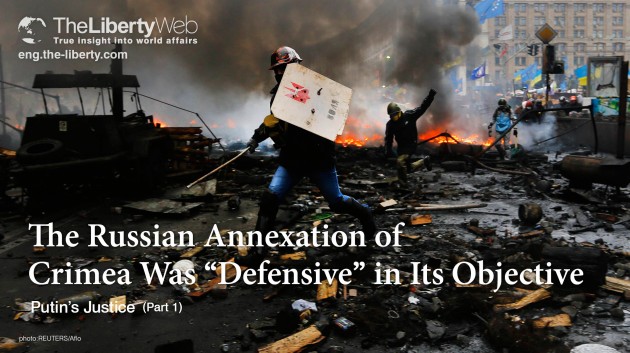The Russian Annexation of Crimea Was “Defensive” in its Objective
Putin's Justice (Part 1)
In the capital of Ukraine, Kiev, some 100 thousand protesters gathered, occupying the central square, and sought EU membership. A riot broke out among a portion of the protesters, and on February 20th alone, over 100 people died. This photo was the square where the protesters disbanded.
Part 1
The Russian Annexation of Crimea Was “Defensive” in its Objective
 Russia Criticized for Annexing Crimea, Using Military Force.
Russia Criticized for Annexing Crimea, Using Military Force.
In Part 1, We Will Close in on the Real Reason Behind Russia’s Annexation of Crimea.
“Armed Men Occupied Government Buildings in Ukraine’s Crimean Peninsula”
On February 27th, when this news was first reported, and with Russian flags flying over the government buildings, western media were suspicious of Russian military for having had hand in this incident. Shortly thereafter, President Putin deployed troops in order to protect Russian citizens, and took over the Crimean Peninsula. Crimea was later annexed to Russia after a public referendum.
Western nations fiercely opposed this move. British Prime Minister Cameron suggested that “…we should discuss whether or not to expel Russia permanently from the G8…”, while Secretary of State Clinton, who is a strong candidate for the next President of the United States, said “…it’s like what Hitler did back in the 30’s”. The West moved to impose sanctions on Russia, and Western-Russia relations deteriorated to a level unseen since the fall of the Soviet Union.
Deploying Troops to Protect Russian Citizens
The Ukraine crisis started last year in November when the “pro-Russian” Ukrainian President Yanukovych canceled efforts to acquire an EU membership. This resulted in 100 thousand strong, pro-Western demonstrators in Kiev, some of whom became violent. The turmoil spread to the rest of the nation, resulting in hundreds of civilian deaths.
Western media did not report on it, but during this turmoil, many Russian citizens in the
Ukraine became the victims of violence. Later, when Yanukovych failed to tame the violence and escaped to Russia, the Ukraine was left without a government.
The Russian take-over of Crimea came soon thereafter. “The protection of ethnic Russians”, which was reported as the excuse for the annexation of Crimea, was actually a necessary measure, and was not an annexation based on territorial ambitions.
Furthermore, Russian public sentiment is that Crimea was originally its
territory.
During the Soviet era, a part of the Communist leadership unilaterally decided that Crimea was Ukrainian territory. Approximately 60% of the residents were ethnic Russians, and a referendum on the annexation of Crimea resulted in a 97% favorable vote. In Mr. Putin’s own words, Russians thought that “Crimea was an indivisible part of Russia”.
The West Abandoned Ukraine, While Russia Moved to Save It
Even as Ukraine gained independence after the collapse of the Soviet Union, it failed to create a solid economic foundation due to widespread corruption, and it faced a financial crisis. In February of this year, its foreign debt reached $140 billion, or 80% of its GDP. For this reason, its dependence on its larger neighbors, the Ukraine couldn’t decide whether to join the Russian sphere or the EU.
The EU mandated that Ukraine had to improve its fiscal situation through the reduction
of public employees and by increasing utility bills. The reason was that the EU did not wish to take on another nation with large public debts similar to Greece. On April 10th, Mr. Putin mentioned in his speech that the “Ukraine’s trade balance (with the EU) was $10 billion in debt”, pointing out that the EU had not only been unable to rescue the Ukrainian economy, but had actually exacerbated its suffering.
So how would Russia compare in this regard? Of the $82 billion in Ukrainian
exports for 2012, $23 billion came from trade with Russia. In eastern Ukraine, steel and defense industries are geared toward serving their Russian clients, which show the depth of their relationships.
Russia provides Ukraine with cheap natural gas as well as much needed investments. Even after having its natural gas stolen from the pipeline, or falling behind on gas payments, Russia has continued to support the Ukraine. While many Western nations including EU members have been critical of Russia’s actions, it has been Russia, not the EU, which has been supportive of the Ukraine.
NATO Has Continued to Betray Russia
When Mr. Putin was inaugurated in 2000 as President, he cooperated
with the United States. After 9/11, Russia was one of the first nations to respond with support, and they worked together when the US invaded Afghanistan and when he voluntarily removed Russian military bases from Cuba and Vietnam.
However, contrary to Mr. Putin’s cooperative engagements, NATO, and
especially the United States, have been applying pressure on Russia. U.S. President George W. Bush persuaded Estonia to join NATO, and began negotiations to allow Georgia and the Ukraine to join, essentially expanding “NATO territory”.
The American columnist, Patrick Buchanan, pointed out how the United States
continued to betray Russia by “allowing Eastern European nations to join NATO after promising not to do so”.
For Russia, not only did allowing the Ukraine to join the EU mean that NATO forces would be at its doorsteps, it also meant that Russia had to protect the Crimean Peninsula because it has served as Russia’s main port for its Black Sea fleet.
A Commonly Held Understanding:
Putin annexed the Ukrainian territories out of territorial ambition.
The Result of Part 1:
Putin has continued to support Ukraine economically, and had to annex Crimea to protect its Russian residents.



















